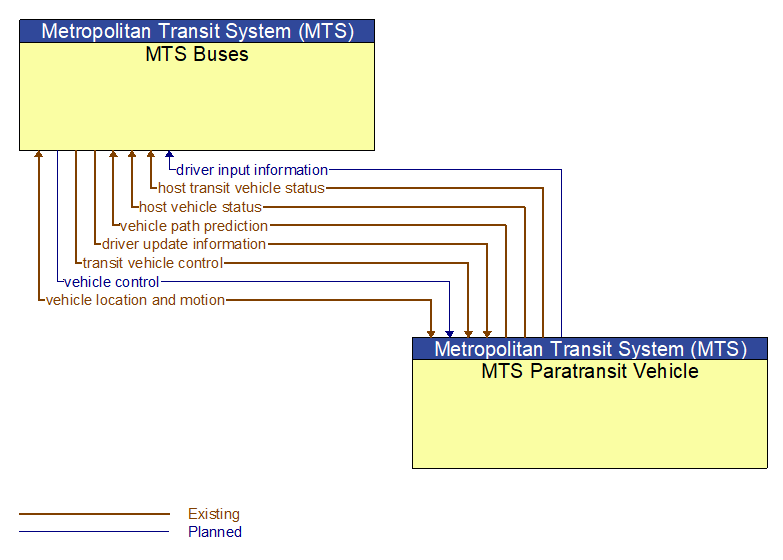Interface: MTS Buses - MTS Paratransit Vehicle

Information Flow Definitions
driver input information (Planned)
Driver input received from the driver–vehicle interface equipment via the vehicle bus. It includes configuration data, settings and preferences, interactive requests, and control commands for the connected vehicle on–board equipment.
driver update information (Existing)
Information provided to the driver–vehicle interface to inform the driver about current conditions, potential hazards, and the current status of vehicle on–board equipment. The flow includes the information to be presented to the driver and associated metadata that supports processing, prioritization, and presentation by the DVI as visual displays, audible information and warnings, and/or haptic feedback.
host transit vehicle status (Existing)
Information provided to the ITS on–board equipment from other systems on the Transit Vehicle Platform.
host vehicle status (Existing)
Information provided to the ITS on–board equipment from other systems on the vehicle platform. This includes the current status of the powertrain, steering, and braking systems, and status of other safety and convenience systems. In implementations where GPS is not integrated into the Vehicle On–Board Equipment, the host vehicle is also the source for data describing the vehicle's location in three dimensions (latitude, longitude, elevation) and accurate time that can be used for time synchronization across the ITS environment.
transit vehicle control (Existing)
Control commands to transit–specific hardware supporting transit fare collection, passenger counting, traveler information systems, and other transit–specific control systems on–board the transit vehicle. This flow also includes the signal disabling or enabling transit vehicle operation sent as a result of a transit vehicle operator authentication failure or a remote disable command. See also 'vehicle control', which includes general control commands that are applicable to all vehicles.
vehicle control (Planned)
Control commands issued to vehicle actuators that control steering, throttle, and braking and other related commands that support safe transition between manual and automated vehicle control. This flow can also deploy restraints and other safety systems when a collision is unavoidable.
vehicle location and motion (Existing)
Data describing the vehicle's location in three dimensions, heading, speed, acceleration, braking status, and size.
vehicle path prediction (Existing)
The predicted future vehicle path of travel. This flow includes an indication of the future positions of the transmitting vehicle that can be used by receiving vehicles to support coordinated driving maneuvers and enhance in–lane and out–of–lane threat classification.